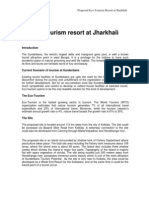JLL Report - Student Housing
JLL Report - Student Housing
Uploaded by
jeetchakraborty61414Copyright:
Available Formats
JLL Report - Student Housing
JLL Report - Student Housing
Uploaded by
jeetchakraborty61414Original Description:
Copyright
Available Formats
Share this document
Did you find this document useful?
Is this content inappropriate?
Copyright:
Available Formats
JLL Report - Student Housing
JLL Report - Student Housing
Uploaded by
jeetchakraborty61414Copyright:
Available Formats
Student Housing
A new dawn in Indian real estate
India Hospitality Industry Review | 2016 1
2 India Hospitality Industry Review | 2016
Preface
The winds of change are blowing fast across India’s economic landscape. Given the on-going phase of
market transformation, largely driven by the actions of a proactive policy-adoptive Modi government,
corporates and investors are both carefully waiting and watching the unfolding impact. Closer home, the
bearing on an already frail real estate economy, clearly sensitive to macro changes, can be interpreted as
manifold.
It is during these times that harnessing innovation is of the utmost importance. And one such innovation
is to deep-dive within the world of alternative asset classes. Given that they have been largely unexplored
within the Indian realty construct, the time has come to examine the potential these classes offer, albeit
a bit more in detail. Once such is Student Housing, which has tremendous potential for all stakeholders.
For developers, it provides a window to diversify from the presently turbulent sectors of mainstream real
estate. For asset management entities and funds, it is an emerging segment with the potential to offer
returns, much higher than established assets of office and retail. For the government, this is one way of
promoting their manifesto on skill development & education by putting together an enabling environment
for students from every quarter. For universities, it is an avenue to enhance ex-domiciliary campus
amenities without fretting much about their limited financial muscle.
Globally, we have seen Student Housing advancing up the growth curve swiftly and in the process become
a part of mainstream real estate asset classes across quite a few geographies. India however, has a lot to
catch-up with, given that we are only making a start now. I am confident that this paper will offer a better
understanding of this new but rapidly evolving asset class.
Ramesh Nair
CEO & Country Head
JLL India
India Hospitality Industry Review | 2016 3
Introduction
From an organised Real Estate Currently, India has approximately 34 “student housing” opportunity becomes
perspective, student housing as a million students in the higher education more visible. Existing developers or
concept is non-existent in India. While space, which is more than double the operators of student housing seem very
access to accommodation facilities within size of the advanced and large student excited at the potential for expanding
the campus is a preferred option for most housing markets in the West. Given the current capacity by close to 100% every
students during their graduation period, lack of enough supply, unmet demand for year for the next 4-5 years if their funding
the number of such hostels available student housing is very high in India. For constraints end. Through this paper, we
often falls short of the total requirement. instance, the ten leading states in attempt to bring the focus of various
Many times, amenities offered in terms of the number of students in the stakeholders – government, developers,
campus hostels are not enough to offer higher education space experience an educational institutions and investors
a comfortable stay for students coming unmet demand to the tune of 30-60%, – to this emerging asset class within the
from different walks of life. Those who as per official statistics available. real estate continuum. With support from
are unable to find hostel accomodation the government in terms of tax incentives
Few developers have spotted this vast
within the campus are compelled to to developers, the student housing
unmet demand as an opportunity to
look for options like paying guest in initiative could help bridge a larger social
enter this segment particularly at a time
residential apartments located near concern about low student enrolment,
when they have been experiencing a
colleges. Typically, such options are not women participation in higher education,
slowdown in the residential real estate
only relatively expensive but also lack the attracting more foreign students into
space. An attractive rental yield,
desired layout and necessary amenities India and so on.
expected at around 15-18% now,
that a student would wish for.
will surely bring in more players as the
34 million Expected
students occupancy
USD 200
in higher level – 95%
billion worth
education Unmet plus
Expected of global
demand yield rate of stock (2016)
for student 15% – 18%
housing is and EBITDA
high: margin of
30% – 60% 30% – 35%
across the
top states
74% of
students
concentrated
in the top 10
states
4 India Hospitality Industry Review | 2016
1 International
Benchmarks for
Student Housing
Though student housing is an emerging asset
class in India, it is well-established in many
other parts of the world. It first became an
organised asset class in the USA, followed
by the UK, which is often considered a
benchmark in the global student housing
market. Australia is another leading emerging
market for student housing in the Asia Pacific
region, and we have included few trends from
that market too.
For its maturity and
depth, student housing
market in the UK could
be considered as a
benchmark for India to
emulate.
Student Housing - A new dawn in Indian real estate 5
GLOBAL STUDENT HOUSING EVOLUTION TIMELINE
2000 2015
USA 2002 UK 2003 AUSTRALIA 2013 INDIA 2016
Yield Rate 2002: 8.5% Yield Rate 2003: 10% Yield Rate 2013: 7.7%
Yield Rate 2016: 6% Yield Rate 2016: 4.5% Yield Rate 2016: 7%
The US market became organised in At present, India’s student
1985, however the growth was slow housing market is too
& gradual at that time. It picked- small but it is moving
up momentum as well as investor swiftly towards becoming
interest 2002 onwards organised
UK
The UK student housing market, as mentioned previously, is one of the more mature markets globally and it has seen tremendous
success. Though student housing as a concept existed in the UK for a long time, it was in the early 2000s that the market was exposed
in a big way and witnessed increased transactions. During the 1990s, there were only a few transactions sighted. The following years,
however, saw trading of large portfolios with volumes in excess of GBP 400 million per year.
Despite being well-established, the
numbers above clearly show that the
UK student housing market is still
an undersupplied market. In the
established markets, demand for student
housing coming from international
students is only a subset of the overall
Total number of Total number of Total number of demand. Many would believe that
international students comprise of a
student PBSA provided international student large share of student housing market in
2.3 million 600,000 438,000 mature economies.
Source: 2016 statistics, JLL Global Research.
However, given that local students too prefer to take benefit of the enabling environment (in terms of amenities) that student housing
offers, even mature markets remain under-supplied. According to JLL Global research reports, the student housing market in the UK
records high occupancy rates of approximately 95%.
6 Student Housing - A new dawn in Indian real estate
Student housing in the UK exists in investors now look to build cross-border
various formats. The primary grade portfolios with a mixture of established
schemes offer premium facilities and markets and emerging markets that
amenities. The secondary grade schemes exhibit strong growth potential.
offer basic facilities and amenities and Investors in the sector are a mixture of
are lower in rent than the primary grade private equity, sovereign wealth and
schemes. Examples of major student institutional investors. The scale of
housing brands include Urbanest, Nidos, investment in the market since 2014
Unite and Downing. shows that there has been significant
Over the years, the UK has developed consolidation through portfolio
several models of student housing, acquisitions, and this has allowed a
many of them now being followed number of big private operators to
globally. These models form the basis increase market share in a relatively
of sharing of responsibilities between short time. In 2011, transactions
academic institutions and private totaled around USD 1 billion in the UK
developers. market. In 2016, this number reached
USD 3.2 billion, a CAGR of 26%.
Student housing, like other asset class,
gets actively traded across major markets
and there is sufficient investor appetite
in the sector. More recently, many
Models in the UK
Management Build, own, Develop, Wholly
only providers operate strata sell and integrated
transfer (BOOT) manage
Student Student Student accommodation Student accommodation
accommodation accommodation is developed and units providers who develop,
providers collaborate providers collaborate / beds are strata sub- own and manage the
with universities or with universities or other divided. The units are sold student accommodation
private developers educational institutions to individual investors properties themselves.
to provide marketing on a long-term lease on the basis that they
and operational to build, own and may only be used for
management services at operate the student student accommodation
new or existing facilities. accommodation. and are leased to the
student accommodation
operator.
Student Housing - A new dawn in Indian real estate 7
USA and Australia: These investors seek early investment
opportunities into the Australian student
The USA and Australia are both student
accommodation market. They are
housing markets but they are very
essentially focused on prime assets
different in nature. The USA was the first
managed by experienced operators,
student housing market to develop and
with a view to benefiting from yield
it’s demand largely comes from internally
compression as more liquidity enters the
migrated students. Whereas, Australia
market.
is one of the most recently developed
markets, and it has a higher proportion of
foreign students.
The USA was also the first market that
saw student housing transition from an
unorganised market to an organised
TRANSACTED VALUE IN THE USA FOR
alternative asset class in 1985. Although
STUDENT HOUSING
student housing as an asset class is the
oldest in the USA, it still has the potential
to grow and develop. Approximately
16 million students get enrolled
into colleges across the US, with
international students totaling around
850,000. Total beds in the US is 2.9
million (across all formats). Demand
is largely driven by students migrating
internally. According to JLL surveys
conducted in 2016, the occupancy rate
was indicated at 96% approximately.
This market is growing fast in terms of
investment from institutional investors.
As seen in the adjacent graph, the Source: JLL Global Research
transacted value for Student Housing in 2
years has observed a tremendous growth,
and this shows that though the USA is an
established market, Student Housing is
growing rapidly.
Student housing in Australia started to
develop as an organised asset class very
recently and is still at a nascent stage.
There are close to 1.4 million students
of which 290,000 are migrants in
Australia. With merely 51,289 beds in
supply, the demand-supply gap is very
wide. This asset class is in developing
stages and therefore the market is an
emerging one. An occupancy rate in
excess of 90% would be typical for most
existing developments.
Despite the limited amount of investible
and operational student accommodation
assets, the Australian market has
attracted interest from a number of large
national and international investors.
8 Student Housing - A new dawn in Indian real estate
2 Student Housing
Market in India
There are currently 34 million students
in higher education in India. Higher
education includes students studying
at the undergraduate, postgraduate,
diploma, certificate, PG Diploma, MPhil
and PhD levels. Such students often fall
into the age group of 18 to 24 years old.
The broad picture of the number of
than just international students and a
prime example of this is the USA, where
just 5% of the student population are
international students with internal
migration within the US accounting for
the bulk.
students in India, compared to the three
biggest student housing markets globally
India is similar to
is shown in the graph on the following the market of USA,
page. The sheer volume of students in where the demand for
India is one reason why student housing
Student Housing will
is considered an attractive investment
proposition amongst the alternative real come from within India
estate asset classes. Moreover, recent migration, although it
compression of yields in the commercial could look up to the UK
sector and slowdown in residential
sales have resulted in developers
market for formats and
focusing on alternative asset classes. As policy environment.
it has been established in the previous
chapter, the demand comprises more
Student Housing - A new dawn in Indian real estate 9
The graph below depicts how higher
NUMBER OF education student population has grown
STUDENTS IN THE since 2003. India has seen a steady rise in the
STUDENT HOUSING number of students, growing at a high CAGR
MARKETS. of 9.2% since almost a decade. Even if growth
in number of students is low from here on, the
volume is very high and will generate demand
for student housing over a long period.
Source: HRD, Government of India and JLL
NUMBER OF
STUDENTS
IN INDIA
SINCE 2003
in Million
Source: HRD,
Government of
India and JLL
The graph below highlights the top ten states with the highest number of students, and it helps us identify the educational hubs in
India. The top ten states account for 74% of the student population in India and it is in the educational hubs that student
housing will be needed the most.
NUMBER OF
STUDENTS IN THE
TOP STATES AND THE
ENROLMENT NUMBER
Source: HRD, Government of India
10 Student Housing - A new dawn in Indian real estate
Student housing in India is a highly unorganised
market where the main forms are campus housing,
private hostels and the residential paying guest
format. Supply in the paying guest format is difficult
to quantify; however, the total number of beds
in campus housing and private hostels currently
available in India is close to 6.1 million. The number
of beds available in the top ten states is shown in
the graph below.
NUMBER OF
CURRENT BEDS IN
THE TOP STATES
Source: HRD,
Government of India
NUMBER OF NUMBER OF PROPORTION
INTERNATIONAL STUDENTS (2016)
STUDENTS (2016)
860,000 16,000,000 5%
430,000 2,280,805 19%
266,048 1,410,133 19%
Source: JLL Global Research
Student Housing - A new dawn in Indian real estate 11
10.4 mn
Estimated number of
This number does not take into account the
international students. Student accomodation can also
be considered by those students who live in the same
migrant students in India city but at a distance from the university.
The UK and Australia have a considerable Since 2010, there has been a 67% increase
percentage of foreign students who in the student population and a 29%
contribute towards the overall demand increase in the number of universities.
for student housing. However, in the USA, With many established private universities
foreign students account for only 5% of coming up over the last 5-7 years, we could
the total student population. India has easily assume that the share of migrant
an international student population of population for higher education would have
about 42,300, which definitely adds to the grown significantly. If we were to assume
demand for student housing. However, 30% students to be migrants, core demand
like the USA, India’s student housing for student housing would be anywhere
demand will come primarily from around 10.4 million students. As against
domestic students migrating to other that, official statistics put the supply at 6.1
states/districts for education. million beds, suggesting a massive unmet
A 2010 UNESCO report suggested that demand. While the official supply statistics
there were 3.85 million migrants for do not include residential paying guest
higher education in India. This was 19% format, but we strongly believe such supply
of the total student population then. will become less preferable to students.
12 Student Housing - A new dawn in Indian real estate
If we were to break-down the demand- could be specific cities or towns within
supply gap at state-level, the graph below these states that remain under-supplied,
highlights the same for the top ten states as revealed through surveys of developers
identified previously as educational hubs. currently operating in the student housing
The graph does not take into account space in these regions.
foreign students and focuses mainly on One can easily identify cities within each
internal migration within India. These of these states that have established
are the states with the highest number themselves as a hub for students
of students; however, there is a severe pursuing higher education. For instance,
shortage with respect to the number of Maharashtra has been one of the under-
beds needed. Education hubs such as supplied states in terms of student
Maharashtra and Rajasthan have a very housing and this could draw attention
strong unmet demand percentage that of developers to markets such as Pune,
exceeds 60% and highlights the potential Mumbai, Kolhapur and Nagpur. While every
for development. While states such as state would have its own education hub
Tamil Nadu, West Bengal and Andhra and developers should look for granular
Pradesh show a different trend, there details on demand-supply dynamics, some
cities will always emerge as attractive
destinations within these states.
NUMBER OF MIGRANT STUDENT AND NUMBER OF
BEDS IN TOP STATES
1,800,000
1,600,000
1,400,000
1,200,000
1,000,000 Oversupplied
800,000
Markets
600,000
400,000
Source: HRD,
200,000 Government of
India and JLL
-
Student Housing - A new dawn in Indian real estate 13
3 A Vision for Student Housing
market in India
As the market is currently shaping
up in India, few student housing
operators-cum-developers have been
at the forefront of delivering student
housing projects. In this chapter, we
share some key insights received from
these developers in terms of market
activity, operational models that are
Having spoken with
developers who are currently
shaping-up the student
housing asset class in India,
their vision for the sector and
being explored, return expectations their expectations on returns
and focus geographies. The developers is worth mentioning.
whom we contacted were IndeCampus,
CampusVille, YouthVille and Aarusha
Homes.
14 Student Housing - A new dawn in Indian real estate
Following table summarises key findings from a survey of student
housing developers:
Major presence /
Focus cities
Current capacity Expected
Hyderabad, Pune,
(beds) occupancy rate
Bengaluru, Chennai,
6,500+ 95-98%
Indore, Kota,
Dehradun
Expected 5-yr Categories of Pricing (in INR)
student housing Basic: 90,000+
CAGR in the
available
number of beds Medium: 120,000-
- Basic 180,000
provided
- Medium
95 - 100% Premium:
- Premium
175,000+
Average area per Expected Expected The student housing market works with various kinds
student (sq ft) yield rate EBITDA margin of schemes and we have divided them into three
150-180 15-18% 30-35% categories with respect to the services packages that
are being considered. The pricing depends on the
amenities provided and other parameters.
Basic: Food, Laundry, Wi-Fi and Security
Medium: Food, Laundry, Wi-Fi, Security, Transport,
Housekeeping and AC Rooms
“Today students need a homelike atmosphere with all the
facilities within a reasonable distance. They also need Premium: Food, Laundry, Wi-Fi, Security, AC
interaction spaces outside the residence where they can Rooms, Swimming Pool, Medicare, Transport,
discuss, study, and entertain in a group. There is a need to Intercom, Student Bonding Events and Personal
have a different kind of security and health environment Mentoring for Students
created to meet their specific needs as well as address the
concerns of parents who are sending them for study. With the It is important to note that existing hostels are
migration of students from rural to urban areas and metros completely different from the formats envisaged for
student housing has very big potential.” Student Housing formats. Currently, hostels merely
offer shelter with food in order to take care of the most
Cdr. Manoj Bhatt (Retd.)
CHIEF ADMINISTRATION OFFICER (CAO) compelling requirements of students. The vision for
IIM AHMEDABAD this asset class will entail a package of services and
host of amenities that will be offered to students,
all-inclusive in the fees payable and provide an ideal
environment for well-rounded development of
students. The vision for this asset class is to provide
holistic living for all students.
Student Housing - A new dawn in Indian real estate 15
A key aspect emerging from our survey of
developers was that each had ambitious
plans to scale up their existing capacity
by close to 100% annually for the next 4-5
years. They were eager to quickly increase
the share of organised student housing.
The survey revealed that the developers
have in mind their focus cities, which were
similar to the ones we identified from the
top education states previously. Pune and
Bengaluru featured high on the list of almost
every developer because these cities have a
very significant concentration of students as
can be also seen in the graph below. While
the district-wise total number of students
was difficult to decipher, a total number
of students appearing for exams from
universities across cities acted as a close
proxy.
High property prices in cities such as Mumbai
and Delhi was one of the main reasons cited
by developers for not considering those in
the beginning. Rather, developers were keen
to focus on markets such as Hyderabad,
Indore and Kota. These markets have a high
density of students and property prices that
will render attractive investment.
TOTAL STUDENTS APPEARING FOR EXAMS FROM
UNIVERSITIES ACROSS INDIAN CITIES
(proxy for district-wise student population)
Source: UGC
16 Student Housing - A new dawn in Indian real estate
4 Investment Landscape for
Student Housing
Student housing is an alternative asset class in real estate, which
ideally would fall under the commercial asset class category being
a rent-yielding asset. Globally, total stock of student housing is
valued at USD 200 billion, although a share of individual market
could not be ascertained through credible sources.
The annual transacted value totals USD 20 billion for 2016 (JLL
Global research) worldwide divided into the following countries:
USA UK GERMANY AUSTRALIA NETHERLANDS FRANCE SPAIN
10.3 3.5 2 1.8 1.5 1.05 0.08
ALL NUMBERS IN USD BILLION
It is important to note that the UK student housing market started to evolve in 2003 and it took about eight years for transactions
value to touch USD 1 billion. Subsequently, Australia took three years to hit that mark. This shows that investors are looking at this
asset class aggressively even in the emerging markets. The graph below highlights that student housing yield rates are outperforming
commercial yields in most markets
YIELD RATES OF COMMERCIAL AND
STUDENT HOUSING (2016)
Source: Bloomberg
Student Housing - A new dawn in Indian real estate 17
In the table below, we try to ascertain through a basic costing model the profitability
that a developer can expect from a Medium (in between Basic and Premium) student
accommodation project. Most of the revenue and capital expenditure figures are
arrived at through surveys and market observation.
Student Housing is
a commercial rental
yielding asset class,
which globally has
always out-powered
the yield rate of
office sector.
Student revenue (INR) 180,000 per student per annum
EBITDA margin 54,000 per student per annum
EBITDA margin % 30% %
Capital Expenditure (INR) 360,000 per student*
Per student area 180 sq ft
Per student rent yield 300 INR/sq ft/annum
Investment Yield % 15% %
Project Size and Investments
Project size (number of beds) 1,000 2,500 5,000
*Excluding Land Cost
Capital Expenditure* (INR crores) 36 90 180 Source: JLL Research
18 Student Housing - A new dawn in Indian real estate
The graph below shows the yield rates in India for commercial (office) and retail for the past ten years. The
expected yield rate for student housing is pitched at anywhere between 15-18%, which is significantly higher than
yield realised through the two commercial asset classes. This is mainly because of the high, unmet demand and
the potential market size in India.
YIELD RATES OF COMMERCIAL AND RETAIL IN INDIA
20%
18%
16%
14%
12%
10%
8%
6%
4%t
2%
0%
(expected) Source: JLL Research
“We see a pattern building up and in next 5 years close
to 1 billion dollar or more of funds chasing this sector.
This will lead to an exponential growth pattern and will
be the only asset class for remarkable returns for next
2 decades.”
Saket Jalan,
CAMPUSVILLE
Student Housing - A new dawn in Indian real estate 19
5 Social benefits of Student
Housing
The National Education Policy (NEP) has been recommending that spending on the
education sector must rise to 6% of GDP as against close to 3.5% of GDP in recent
years. The policy envisages this increased spending will help not just in enhancing
the quality of the education programme but also amenities and infrastructure,
including accommodation. India can aspire to be an education hub within
South East Asia if it were to focus on improving the overall experience of
career aspiring students.
The potential for student housing in India is huge, as we have seen in previous
chapters that outlined the demand-supply gap and the investment potential. The
NEP also outlines the importance of private entities in helping to raise resources
and shape the sector. Moreover, several private universities have been encouraged
to start operations in India in order to foster quality education and provide more
options for aspiring students.
India can aspire to
become an Education
Hub for South-East
Asia if right initiatives
are taken by the
government.
20 Student Housing - A new dawn in Indian real estate
The ongoing reform in the policy framework is encouraging,
although at present most students remain uncertain about
migrating to other cities in pursuit of a better education,
especially when it comes to getting admitted to colleges
with no accommodation facilities for all of its students.
The plight of existing hostels is such that the number of
students residing in them is higher than the total intake
capacity. Given that the government targets enrolment
of around 30% by 2020 (meaning the student enrolment
number could likely go to 40 million students by 2020), we
GROSS ENROLMENT RATIO:
can expect a lot more demand for hostels, assuming that
FASTER RISE IN ENROLMENT OF STUDENTS the interstate migration of students will also rise.
IN RECENT TIMES
Source: UGC
Student Housing - A new dawn in Indian real estate 21
CAPACITY CONSTRAINTS
ACROSS UNIVERSITY
OPERATED HOSTELS
Source: UGC
1. As enrolment rises, capacity Given the central assistance available,
constraints would be felt across the universities and affiliated colleges would
existing student accommodation want to focus on improving the course
2. W
hile the Education Ministry and curriculum and amenities in order to
the University Grants Commission of attract more students. However, with
India (UGC) are making an effort to limited resources at their disposal,
build hostels, it would be better to educational institutes may find it difficult
open up the market for the private to shore up campus facilities as much
sector. as required. For instance, according
Given the intrepid target of taking to UGC annual reports, 70-75% of the
India’s Gross Enrolment ratio (GER) to maintenance expenditure of universities
30% over the next three to four years, (especially the central universities) is
the government would be expected on salaries and allowances alone. In
to have a clear strategy in place. As addition, while many universities have
stated in a UGC report, the 11th five- large campuses, funding from state
year plan proposed a dual strategy to government or central agencies usually
achieve this target: do not take into account expenses
related to municipal and other local
• The first component of this strategy
services (expenses related to property).
involves increasing the number of
This means that building hostels would
universities, colleges, and vocational
require diverting a lot of funds away from
and technical institutions
areas such as increasing the number of
• The second component of the
courses and classrooms. Universities
strategy centres on enhancing
would prefer, therefore, accommodation
the intake capacity of existing
related aspects are managed externally,
educational institutions
as this would occupy a considerable
This clearly indicates a potential rise amount of human as well as financial
in density of students across Indian resources.
universities.
22 Student Housing - A new dawn in Indian real estate
Government focus is required of the profits from student housing. to enter the space.
in the following areas: However, in order to facilitate private • Once the conditions or operating
sector participation in the sector, criteria is set, a profit & loss analysis
For the student housing sector to help
the government could consider through valuation studies can be
promote India’s vision of becoming an
providing certain tax incentives that done to ascertain the acceptable
education hub in the region, we propose
will make the market attractive to level of profits earned by the student
the government take the following
operate in. housing developer & operator.
measures:
• For this purpose, the government • After the level of acceptable profits
1. Incentivise the private sector by
may first consider setting standards from student housing is determined,
providing tax incentives.
for student housing amenities or a tax waiver can be announced
service offerings that will act as a for operators with an income level
Currently, there is no special
guide to private developers planning determined by the authorities, with
consideration for student housing in
India in terms of the tax treatment additional income above that level
subject to standard tax rates.
• Since student accommodation
also includes providing for meals,
cleaning & laundry, etc., even these
services should be incorporated
into the non-taxable income level
at a basic predetermined level of
expenses.
• Respective state governments may
ICON HERE want to consider concessions on
property taxes in order to facilitate
education-related amenities, given
the basic operating framework is in
place.
2. The HRD Ministry or the UGC could
help in the standardisation of
amenities and services.
The ministry has to consider this
important step before any sort of
tax relief or other considerations
are offered to the developers and/
or operators of student housing.
Currently, India does not have any
“While there is ample demand for
such criteria laid down defining
student housing, universities & colleges
the quality of service or amenities
are facing resource constraints to create
required for student housing.
the required supply. Private sector
participation needs to be encouraged in
the Student Housing space in order to
bridge the demand-supply imbalance.
Fiscal and non-fiscal incentives from the
government at policy level will go a long
way in boosting the supply of Student
Housing stock.”
Shobhit Maleta
INDECAMPUS
Student Housing - A new dawn in Indian real estate 23
There are examples that can be looked
Pertains to aspects
at in the UK or other developed student such as qualifying
housing markets. For instance, we criteria for becoming General
looked at guidelines/codes released an operator of student guidelines
housing, structural on service
by Accreditation Network UK (ANUK),
requirements commitments
especially for private student housing
and changes, and
operators not affiliated with any
disclosures to the
university. Although criteria with respect To make sure there is
authority (ANUK), etc.
to an area are not defined and rightly no bias while allocating
dwellings to persons of a
so (operators may need the flexibility to Equality and specific community, caste
decide unit sizes based on the available diversity or religion; treatment for
land parcel or planned amenities), people with disabilities;
guidelines with respect to services are and understanding
clearly laid out. These services guidelines To make sure diversity laws, etc.
disclosures are made
cover aspects related to the following: on all possible fronts
in terms of amenities, Marketing of
rights and fees while property prior
advertising the to letting to
property, rules related tenants
to compensatory
action required in
case of inconvenience
to tenants and the To make sure
To put in responsibilities of Services &
timely and regular
place a operators, etc. amenities
maintenance activity
feedback expected during
Tenant is carried out, making
mechanism the tenancy
satisfaction the tenants’ stay
where period
students can criteria comfortable and
share their hassle-free.
experiences
or concerns. Norms that need to
be followed as per
existing rules of the
local municipality with
Health & safety regards to fire safety,
gas and electricity
connections, energy
efficiency and disaster
management, etc.
Guidelines to
follow with regards Assistance
to returning the expected at
deposit fund and the end of the
documentation tenancy period
required, etc.
To put in place
timelines for settling
Dispute redress complaints and details
mechanism on the processes
for approaching the
tribunal, etc
To put in place
timelines for
Attending to
various types of
complaints
dispute settlement
processes.
24 Student Housing - A new dawn in Indian real estate
3. Student housing for women and its role in higher education
The government’s effort in encouraging more families to educate female children beyond the primary level of education
is commendable. Over the last seven to ten years, the rise in the number of female students in higher education has been
phenomenal and they now have a good presence compared with male students.
RISING SHARE OF WOMEN IN HIGHER EDUCATION IN INDIA
Source: UGC
Given the rise of women in higher education, we
expect growing demand for specialised hostels
catering to the specific requirements of women.
While there are efforts by the UGC and the
HRD Ministry to encourage universities to build
more hostels for women, the private sector’s
involvement will be crucial in order to achieve the
desired pace. With the provision of specialised
“Indian universities and institutes have expansion
female hostels, parents will feel much more secure
plans that focus on classrooms not housing. At
about sending female students to other cities for
the same time, more and more young Indians are
better education prospects.
pursuing study beyond secondary school. This
means we should expect growing demand for
Given the right framework through student quality student housing at a time when universities
housing guidelines and by offering reasonable are looking to outsource these services. As an
tax incentives, more players that are private can asset class that makes student housing a smart
be encouraged to participate in building this investment with steady cash flows, while the
asset class. Many countries have encouraged underlying asset (property) will continue to
the Public Private Participation (PPP) model and appreciate. An investment in student housing, is
there is no reason why government institutes an investment in India’s future and will generate
must not explore this format of financing student compelling returns.”
housing, given the limited resources available Satyanarayana Vejella
with the education ministries or the universities. AARUSHA HOMES
This way, the funds available with the universities
can be better utilised for improvising the quality
of curriculum rather than spending on creation of
lodging amenities.
Student Housing - A new dawn in Indian real estate 25
Conclusion
Student housing as a concept is emerging scale up their current capacity by 100% which the UGC annual reports have
in India, although it is a thriving asset on a year-on-year basis for the next 4-5 highlighted repeatedly. With focused
class in established markets of USA years, and would be looking for support incentives and proper guidelines for
and UK, and a fairly large but emerging from funding institutions. student accommodation, we believe
market in Australia. In most countries, The government of India, through the private participation in this sector can be
the asset class commands a yield that is UGC and HRD ministry, have done a encouraged to bridge the wide unmet
higher than commercial real estate (office commendable job in raising the gross demand that exists currently.
and retail) yields. A similar trend can be enrolment levels of students in higher
assumed for the Indian market as well education. This puts India’s education
where commercial yields currently hover statistics favourably when compared
in the range of 8-11%. Most developers to global standards. However, the
who already operate in the student focus now has to be on upscaling the
housing space in India are projecting quality of education and amenities
yields in the range of 15-18%, which is a across its universities and colleges.
reason strong enough to go bullish on this One of the aspects involve improving
sector. Almost every developer intends to student accommodation facilities,
26 Student Housing - A new dawn in Indian real estate
India Hospitality Industry Review | 2016 27
Contacts
For business enquiries
Shubhranshu Pani Subhankar Mitra Rahul Vaidya
Managing Director Local Director Local Director
Strategic Consulting | Strategic Consulting Strategic Consulting
Infrastructure Services | EHS +91 9324292144 +91 9960856543
+91 9820519899 subhankar.mitra@ap.jll.com rahul.vaidya@ap.jll.com
shubhranshu.pani@ap.jll.com
Authors
Suvishesh Valsan Anjali Mittal
Associate Director Consultant
Strategic Consulting Strategic Consulting
+91 9920879808 +91 9870442020
suvishesh.valsan@ap.jll.com anjali.mittal@ap.jll.com
Acknowledgment for their support & contributions:
Philip Hillman James Kingdom Loene Bill David Larkin
Chairman - Alternatives Head - Alternatives Senior Vice President Associate Director
JLL EMEA Research Brokerage Social Infrastructure
JLL UK JLL USA JLL Australia
Noral Wild Hannah Thompson Morrone Michael
Head - Social Infrastructure Alternatives Investor Research Analyst
JLL Australia JLL UK JLL USA
Vineet Goyal Saket Jalan Shobhit Maleta Satyanarayana
YouthVille CampusVille IndeCampus Aarusha Homes
Cover Picture Courtesy: The Oberoi Sukhvilās Resort & Spa, New Chandigarh
STR. REPUBLICATION OR OTHER RE-USE OF THIS DATA WITHOUT THE EXPRESS WRITTEN PERMISSION OF STR IS STRICTLY PROHIBITED.
Jones Lang LaSalle Property Consultant (India) Pvt Limited © 2017. All rights reserved. All information contained herein is from sources deemed reliable; however, no
representation or warranty is made to the accuracy thereof.
28 India Hospitality Industry Review | 2016
You might also like
- Singapore’s Business Park Real Estate: - Viability, Design & Planning of the Knowledge-Based Urban Development (Kbud)From EverandSingapore’s Business Park Real Estate: - Viability, Design & Planning of the Knowledge-Based Urban Development (Kbud)No ratings yet
- International Student GuideDocument29 pagesInternational Student GuideHemera GeorgiouNo ratings yet
- Analysis of Behaviour of Real Estate Rates in India A Case Study of Pune CityDocument6 pagesAnalysis of Behaviour of Real Estate Rates in India A Case Study of Pune CityBhavik NasitNo ratings yet
- India Build and InteriorsDocument36 pagesIndia Build and Interiorsdevendra_abcdNo ratings yet
- Anarock - Mumbai RedefinedDocument52 pagesAnarock - Mumbai RedefinedVilom OzaNo ratings yet
- OYO Catalyst 2019Document6 pagesOYO Catalyst 2019Mohak Gandhi 23No ratings yet
- Kolkata Untapped Real Estate Opportunities: September 2016Document25 pagesKolkata Untapped Real Estate Opportunities: September 2016Aritra DasNo ratings yet
- JLL Trust The Wait Indias Real Estate Investment StoryDocument16 pagesJLL Trust The Wait Indias Real Estate Investment StoryVarun KhannaNo ratings yet
- FICCI ANAROCK Industrial Logistics Report2022Document28 pagesFICCI ANAROCK Industrial Logistics Report2022AdhithyaNo ratings yet
- Housing Sales Taper in Q2 2024 in Top 7 Cities - 8 Y-o-YDocument3 pagesHousing Sales Taper in Q2 2024 in Top 7 Cities - 8 Y-o-YArun ChitnisNo ratings yet
- A Different World Post COVID-19: India Real EstateDocument11 pagesA Different World Post COVID-19: India Real Estatesree24034354No ratings yet
- India Real Estate Office and Residential Market Jan Mar 2024 11093Document8 pagesIndia Real Estate Office and Residential Market Jan Mar 2024 11093Anwesh ChakrabortyNo ratings yet
- Project Riyadh: by AbhishekDocument12 pagesProject Riyadh: by AbhishekItsnot MeNo ratings yet
- MP Real Estate Policy 2019Document20 pagesMP Real Estate Policy 2019Ankur ChourasiaNo ratings yet
- Real Estate May 2023Document33 pagesReal Estate May 2023Varun KhannaNo ratings yet
- Globsyn Business School, Ahmedabad Group 8Document12 pagesGlobsyn Business School, Ahmedabad Group 8Vishek VijNo ratings yet
- Navi Mumbai - The City of PossibilitiesDocument28 pagesNavi Mumbai - The City of Possibilitiesanonymous1999boyNo ratings yet
- RAI-Anarock Retail ReportDocument40 pagesRAI-Anarock Retail ReportNivedkrishna ThavarayilNo ratings yet
- Personal Finance - Introduction Ver 0.4Document59 pagesPersonal Finance - Introduction Ver 0.4Aravind MenonNo ratings yet
- Dawn of Future Cities of IndiaDocument21 pagesDawn of Future Cities of IndiaGOUTHAM G.KNo ratings yet
- JLL Chennai Residential Hotspots ReportDocument32 pagesJLL Chennai Residential Hotspots ReportGnaneswaranNo ratings yet
- C&W India Real Estate Outlook 2009Document52 pagesC&W India Real Estate Outlook 2009rayvk18No ratings yet
- Insite: Mumbai Residential Market UpdateDocument14 pagesInsite: Mumbai Residential Market UpdateDivyesh BhayaniNo ratings yet
- Toyota MotorsDocument31 pagesToyota MotorsSuraj ChavanNo ratings yet
- North Coast Presentation 2024 NewDocument114 pagesNorth Coast Presentation 2024 NewMazen ShohdyNo ratings yet
- Saudi Car Club PresentationDocument21 pagesSaudi Car Club PresentationamgadarchNo ratings yet
- Smart Homes in India White PaperDocument5 pagesSmart Homes in India White PaperRavi AlagumalaiNo ratings yet
- Affordable Housing ReportDocument48 pagesAffordable Housing ReportSeverus SnapeNo ratings yet
- The Indian Housing Finance Market - Going FlatDocument17 pagesThe Indian Housing Finance Market - Going FlatAbhishek NambiarNo ratings yet
- Blue Chip Companies, Market CapitalizationDocument15 pagesBlue Chip Companies, Market CapitalizationAnanthuNo ratings yet
- Land Value CaptureDocument50 pagesLand Value CaptureLisa Pratiwi100% (1)
- (Colliers) APAC Cap Rate Report Q4.2022Document6 pages(Colliers) APAC Cap Rate Report Q4.2022Khoi NguyenNo ratings yet
- ND-Developers-Company Profile PDFDocument11 pagesND-Developers-Company Profile PDFÃvíňâšh Ř ŔäťhőďNo ratings yet
- Hyderabad 2.0 - India's Original IT Hub Continues To Grow - June 2018Document11 pagesHyderabad 2.0 - India's Original IT Hub Continues To Grow - June 2018Srinandhini JayarajNo ratings yet
- Mahindra World CityDocument5 pagesMahindra World Citylibshar900No ratings yet
- Krish Group Project PDFDocument64 pagesKrish Group Project PDFKrish GroupNo ratings yet
- Real Estate Industry in IndiaDocument34 pagesReal Estate Industry in IndiarosabjorkNo ratings yet
- ZOLO Assignment-1Document2 pagesZOLO Assignment-1Kunal AgarwalNo ratings yet
- Gig EconomyDocument3 pagesGig EconomyMehnaz MashreenNo ratings yet
- Indian Real Estate Report 2020Document40 pagesIndian Real Estate Report 2020SRINIVASAN TNo ratings yet
- FundraisingDocument50 pagesFundraisingpriyanka jainNo ratings yet
- Asset Valuation ReportDocument8 pagesAsset Valuation ReportAnik MaityNo ratings yet
- Real Estate Weekly News Letter 6 October 2014 - 12 October 2014Document25 pagesReal Estate Weekly News Letter 6 October 2014 - 12 October 2014Aayushi AroraNo ratings yet
- MahaRERA pptv7Document34 pagesMahaRERA pptv7shivakesarlaNo ratings yet
- India Office MarketView Q1 2019 PuneDocument7 pagesIndia Office MarketView Q1 2019 PuneAbhilash BhatNo ratings yet
- Reliance Realty LLP PDFDocument27 pagesReliance Realty LLP PDFDigendra RathoreNo ratings yet
- DebitsAndCredits BITSPilaniDocument5 pagesDebitsAndCredits BITSPilaniSuhani RathiNo ratings yet
- Competitive Analysis of Zolo by NitigyaTripathiDocument46 pagesCompetitive Analysis of Zolo by NitigyaTripathiNitigya Tripathi100% (1)
- Socio-Economic Structure and Development: Levels of Development in Rudraprayag District, Uttarakhand, IndiaDocument9 pagesSocio-Economic Structure and Development: Levels of Development in Rudraprayag District, Uttarakhand, IndiaIJAR JOURNALNo ratings yet
- Garden City Township MasterplanDocument60 pagesGarden City Township Masterplanaanchal100% (1)
- Co Living Reshaping Rental Housing IndiaDocument17 pagesCo Living Reshaping Rental Housing IndiaShaubhik DasNo ratings yet
- Challenge Roll-Out Plan and FrameworkDocument54 pagesChallenge Roll-Out Plan and FrameworkITDP IndiaNo ratings yet
- Eco Tourism JharkhaliDocument6 pagesEco Tourism JharkhaliAmit ChaudharyNo ratings yet
- Mix Land UseDocument12 pagesMix Land UseSahil SetiaNo ratings yet
- Plywood ManufacturingDocument13 pagesPlywood ManufacturingfruitsplusgeneralstoreNo ratings yet
- Navi Mumbai ResearchDocument4 pagesNavi Mumbai ResearchshahbaztNo ratings yet
- Crypto's Next Bull Run Will Start in Asia Next 2.editedDocument2 pagesCrypto's Next Bull Run Will Start in Asia Next 2.editeddyn keriNo ratings yet
- Unit 4 Urban Planning and Urban RenewalDocument27 pagesUnit 4 Urban Planning and Urban RenewaldafnyNo ratings yet
- Uttar PDFDocument46 pagesUttar PDFb_csrNo ratings yet
- Jaipur: Student Housing As An Emerging Real Estate Segment in IndiaDocument15 pagesJaipur: Student Housing As An Emerging Real Estate Segment in IndiaAditya GagraniNo ratings yet
- Altruist TechnologiesDocument11 pagesAltruist Technologiesjeetchakraborty61414No ratings yet
- BLANKOM All Digital Headend SystemDocument6 pagesBLANKOM All Digital Headend Systemjeetchakraborty61414No ratings yet
- Rolta Mata SecuritiesDocument18 pagesRolta Mata Securitiesjeetchakraborty61414No ratings yet
- BLANKOM All Digital Headend SystemDocument6 pagesBLANKOM All Digital Headend Systemjeetchakraborty61414No ratings yet
- Social Adaptation Strategies and Inclusion Indicatives For Foreign Students of Batangas State UniversityDocument9 pagesSocial Adaptation Strategies and Inclusion Indicatives For Foreign Students of Batangas State UniversityIOER International Multidisciplinary Research Journal ( IIMRJ)100% (1)
- HW 6.2 - Bas-T323wsb-8 - 23005710Document4 pagesHW 6.2 - Bas-T323wsb-8 - 23005710Khang NguyenNo ratings yet
- Job - Job Opportunity For Editorial/Client Account Manager Role For IDP?s Digital Campus ? Chennai (Dlf-It Sez)Document2 pagesJob - Job Opportunity For Editorial/Client Account Manager Role For IDP?s Digital Campus ? Chennai (Dlf-It Sez)Partha SarathyNo ratings yet
- Welcome To Canada? A Critical Review and Assessment of Canada's Fast-Changing Immigration PoliciesDocument34 pagesWelcome To Canada? A Critical Review and Assessment of Canada's Fast-Changing Immigration Policiesravi2311No ratings yet
- Muhammad Affendy Bin Roslan: Work Experience SkillsDocument2 pagesMuhammad Affendy Bin Roslan: Work Experience SkillsTbk GombakNo ratings yet
- The Advantages and Disadvantages of University Study in The United StatesDocument11 pagesThe Advantages and Disadvantages of University Study in The United StatesgkcalatNo ratings yet
- can visaDocument11 pagescan visaakshat.chhabra0608No ratings yet
- India As An Education Destination To Foreigners: - A Case Study of Sharda UniversityDocument11 pagesIndia As An Education Destination To Foreigners: - A Case Study of Sharda Universityarj_nNo ratings yet
- Study at Home: ECCE Writing Resource PackDocument22 pagesStudy at Home: ECCE Writing Resource PackGlykeria Mangela100% (1)
- RFP-call Center - FinalDocument93 pagesRFP-call Center - FinalAnkit UjjwalNo ratings yet
- Essay Writing Guide B1Document8 pagesEssay Writing Guide B1Eduar Aguirre100% (1)
- LEC Module Enrolment Supplement (Updated 11 May 21)Document46 pagesLEC Module Enrolment Supplement (Updated 11 May 21)HollpNo ratings yet
- Study Abroad Budget GuideDocument9 pagesStudy Abroad Budget Guideyuan yoyoNo ratings yet
- FCE HOMEWORKqse (2) 2Document15 pagesFCE HOMEWORKqse (2) 2Rodri MolinaNo ratings yet
- Megha Saliya SOP AusDocument8 pagesMegha Saliya SOP AusEminence SOP WritersNo ratings yet
- M3685 UG Prospectus 2021 - PDF - Update - 100620Document168 pagesM3685 UG Prospectus 2021 - PDF - Update - 100620BorderBRENo ratings yet
- Feedback From Former Students-EurophotonicsDocument9 pagesFeedback From Former Students-EurophotonicsLenon AndetklNo ratings yet
- Planning The Future PDFDocument9 pagesPlanning The Future PDFCarmen BugnarNo ratings yet
- LanguageStrategyInventory MAXSA IGDocument10 pagesLanguageStrategyInventory MAXSA IGSandraNo ratings yet
- Call For Applications Scholarships International Students Enrolling in English 2002-23Document6 pagesCall For Applications Scholarships International Students Enrolling in English 2002-23Strahinja ZekanovićNo ratings yet
- Metch Prospectus 2015 OldDocument58 pagesMetch Prospectus 2015 OldAdiozNo ratings yet
- Studying AbroadDocument6 pagesStudying AbroadTrúc Linh ĐỗNo ratings yet
- 2023 2024 Fulbright Eligibilities and Application RequirementsDocument2 pages2023 2024 Fulbright Eligibilities and Application RequirementsMohammed Amin BenharkatNo ratings yet
- Sungkyunkwan UniversityDocument11 pagesSungkyunkwan UniversityAnnisa PujiastutiNo ratings yet
- SPM TRIAL 2019 - Pahang (Kuantan) - P2Document16 pagesSPM TRIAL 2019 - Pahang (Kuantan) - P2sadariahNo ratings yet
- International Entrepreneurship EducationDocument18 pagesInternational Entrepreneurship Educationkonsultan_rekanNo ratings yet
- Professional Growth Plan Fall 2021Document4 pagesProfessional Growth Plan Fall 2021api-582076623No ratings yet
- Statement of Purpose (SOP) Sample For Information TechnologyDocument6 pagesStatement of Purpose (SOP) Sample For Information TechnologyMy YoutubeNo ratings yet
- Quality Assurance Review For Higher EducationDocument14 pagesQuality Assurance Review For Higher EducationJanice AmlonNo ratings yet




























































































